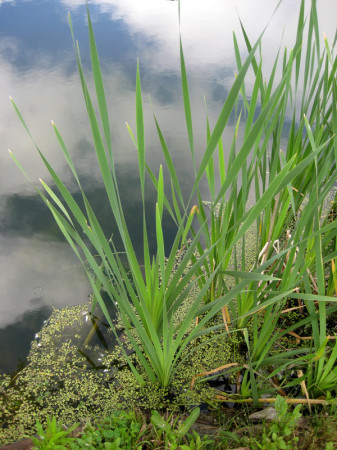
The renowned forager and writer Euell Gibbons called cattails “the supermarket of the swamps,” and from that moniker other nicknames have emerged, among them “the Walmart of the swamps.” Although evoking Walmart doesn’t help me to connect with my joy for wild plants, the sobriquets are so given because of all the different plant food cattails (Typha spp.) yield—from the shoots (aka hearts or leaf cores) and flower spikes to cattail pollen as flour, along with several underground parts, among which the rhizomes require a bit of processing to separate the edible starches. It is also often the case that cattails are quite plentiful where they occur, making them a good choice for a sustainable wild harvest.
The shoots or hearts, also known as “Cossack asparagus,” are best harvested in spring and early summer, prior to the development of the flower stalk. This involves giving a mellow yanking to the inner leaves near the base of the plant until the soft, white core releases, bringing the attached long green leaves with it. I usually cut the leaves off in the field, keeping just the bottom portion to clean in the kitchen.
The Heart: To Cook or Not to Cook?
Since cattail hearts are described as tasting like cucumbers, I decided to use the comparison to come up with a recipe for Hunger & Thirst’s June recipe share. But the recipe idea I came up with requires raw cucumbers, not cooked ones.
Numerous sources say to eat cattail hearts raw or cooked, though in The Forager’s Harvest (2006), Sam Thayer reports “an itchy, irritated feeling” in the back of his throat when he eats them raw, so he prefers to cook them. I get a little of this sensation but it is not uncomfortable, just a bit strange.
I couldn’t help but wonder about the safety of eating raw cattails shoots, which are often found growing in water. Specifically, I was interested in whether cattails growing in water could transmit water-borne parasites like Giardia on the raw hearts.
I emailed Sam Thayer the question, and he seemed to think the parasites unlikely to migrate into the internal environment of the plant . He wrote (2012): “With cattail shoots I don’t think it’s an issue at all. You eat the interior part which is sterile, peeling off those layers exposed to the outside.”
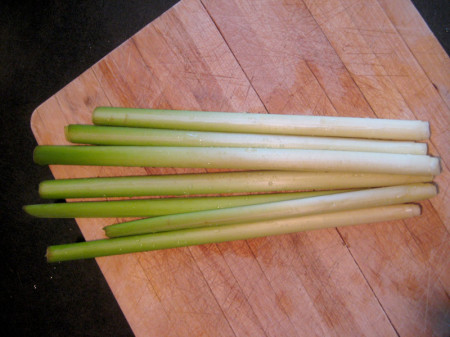
Still, I took extra precautions in the hopes of killing any parasitic hitchhikers, just in case. After a thorough washing, I prepped them by cutting and reserving the bottom, soft part, then peeling a layer of the leaves, then cutting another soft portion off, then peeling another set of leaves, and so forth, until I’d discarded all the tough parts and kept all the soft parts. Sam describes the vegetable as “a little bit annoying” because of the required processing, but I watched crime dramas on TV to distract myself. I cut them into approximately half-inch sections.
Then for extra measure I soaked them in a strong vinegar and water solution for about 12 minutes. Studies seem to indicate that a strong vinegar soak can be effective as a disinfectant (on any vegetable) in reducing Giardia infection rates in endemic areas. In one study, vinegar won out over lemon juice for treating uncooked foods with Giardia cysts, though frankly it did not come close to killing everything in the tube.
Water a Weird Shade of Green? Think Twice.
Cattails accumulate heavy metals, which is why they can be used to clean up toxic sites. If the water that a cattail is growing in is suspicious, you probably want to think twice about foraging for dinner there. “There’s little wrong with a healthy pond but I would stay clear of cattails that get drainage from any kind of road or company,” Green Deane responds to a commenter on his cattails video. “One of the two times I was ill from a foraged plant was cattails below a discharging company I did not know about. I ended up praying to the porcelain god for a while.”
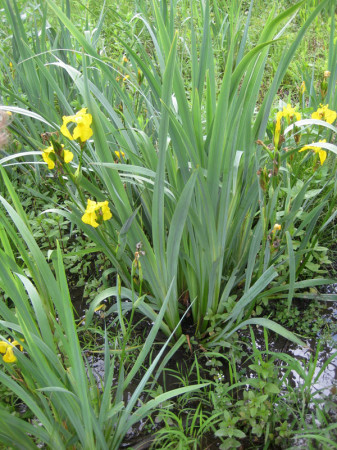
There’s also a related long term concern about eating something that’s polluted that might not make you sick immediately but over the course of time. In Recent Advances in Plant Biotechnology (2009), Kirakosyan and Kaufman describe a study on the uptake of lead by broadleaf cattail (Typha latifolia). Thankfully it found that most of the lead was confined to the roots and rhizomes of the cattail, requiring a chelating agent for the shoots to pull the toxins upward for remediation purposes. Still, it’s probably a good idea not to eat cattail shoots—or any other vegetables, for that matter—growing in suspicious areas.
Edible Shoots or Cossack Asparagus
For these recipes, I harvested cattail hearts from a spring-fed pond. It was hard to tug the shoots out because of the soft mud, which threatened to deliver the entire plant and not just the core. Then I noticed some cattails growing on the dry ground by the edge and got the rest of my harvest there.
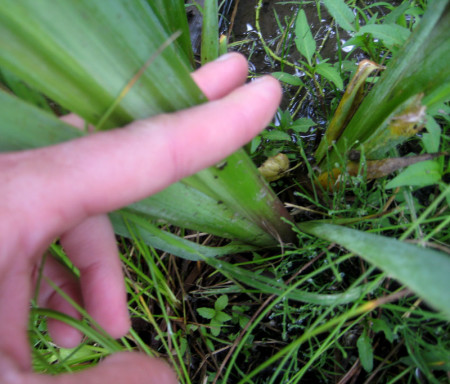
The pond is on a friend’s property, and he is trying to keep the cattails from overtaking it, so he was happy for me to do it. Cattails aid in the conversion of open water to dry land, so those hoping to keep a pond intact may have to pull them. They grow in abundance, something fish pond owners might not always appreciate, but polluted natural landscapes do.
Lookalikes
Cattails have some toxic lookalikes when young, so Deane writes to always look for last year’s growth to find this year’s. Cattails have elongated flower heads, often showing the brown, hot dog, or “cat’s tail” form. Thayer (2006) gives sweet flag (Acorus calamus), which has a flower spike that hangs off the side partway up the leaf instead of pointed vertically at the top of the stalk, as a lookalike.
Irises are toxic lookalikes. The flowers are distinctively Iris, but if gathering prior to flowering, the base of a cluster of Iris leaves is flat in cross section, compared to the round clump of cattails. Steve Brill gives daffodil (Narcissus pseudonarcissus) as another toxic lookalike. Deane adds that cattails are “very mild tasting and without much aroma” so a strong flavored and/or aromatic plant would not be a cattail.
Okay so hopefully you have the information you need to chase down some cattails and try one of these salads:
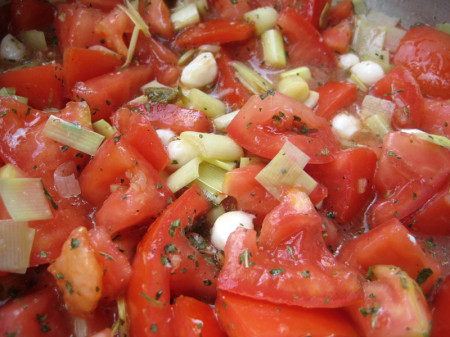
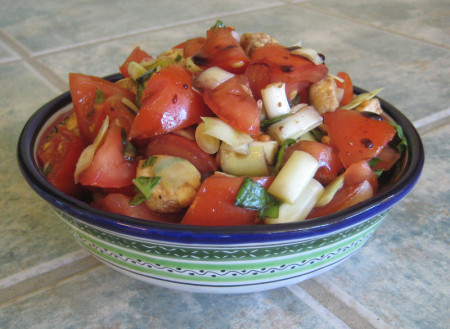
Cold Cattail & Tomato Salad
Ingredients:
Tomatoes, cut into chunks
Cattails hearts, cut into small chunks
Italian dressing
Mozzarella balls
Wild oregano (Monarda fistulosa)
Instructions:
Toss all ingredients together except the mozzarella balls and let marinate for 1-24 hours. Add mozzarella balls and serve.
“Catprese” Salad
Ingredients:
Tomatoes, cut into chunks
Cattails hearts, cut into small chunks
Balsamic dressing
Fresh basil, chopped
Mozzarella balls
Instructions:
Toss all ingredients together except the mozzarella balls and let marinate for 1-24 hours. Add mozzarella balls and serve.
Updated 2.26.21

Lots of great info here, especially the bit about the vinegar soak. Much appreciated.
That looks fantastic. I love Mediterranean salads